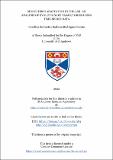Short-term adaptation in the lab : an analysis of evolutionary trajectories using time-series data
View/
Date
15/06/2022Supervisor
Funder
Grant ID
MA16-064
RIG007474
Keywords
Metadata
Show full item recordAbstract
Experimental evolution has led to remarkable discoveries on the evolution of adaptive phenotypes. However, an understanding of the genetic basis of adaptation is only just starting to emerge, especially in eukaryotes. My thesis aims to take full advantage of genomic time-series data by examining Evolve & Resequence (E&R) experiments. This approach typically monitors the genomes of lab populations over the course of several generations. Firstly, I introduce Bait-ER: a fully Bayesian approach to investigate allele frequency trajectories while testing for selection. It implements a Moran model to estimate selection paramaters at each biallelic site. Bait-ER models varying coverage explicitly to account for sampling error. My method is robust even when studying small populations, and it proved accurate in both real and simulated genomic datasets. Secondly, I investigate the response to sexual selection in lab populations of Drosophila pseudoobscura using an E&R approach. These flies were subject to an altered mating regime where the intensity of sexual selection was either relaxed in monogamous populations - M - or intensified in polyandrous populations - E. I resequenced the genomes of each population at five separate time points. I estimated diversity and the effective population size (Nₑ) across the genome, and found that overall estimates of Nₑ match neutral expectations. However, Nₑ was lower at the start of the experiment, especially on the X chromosome in E populations. This indicates that sexual selection is strongest at the start in E lines, and that the X is responsible for early adaptation. Lastly, I performed a genome scan using Bait-ER to detect any potential targets of selection on the full genomic time-series. E lines show a stronger signal of selection where the X dominates, but the third chromosome also seems to be a hotspot. In summary, I found clear signals of adaptation in the genome of lab populations at several levels. This is in spite of strong genetic drift acting to slow down the adaptive process.
Type
Thesis, PhD Doctor of Philosophy
Rights
Creative Commons Attribution-NonCommercial-NoDerivatives 4.0 International
http://creativecommons.org/licenses/by-nc-nd/4.0/
Embargo Reason: Embargo period has ended, thesis made available in accordance with University regulations
Collections
Except where otherwise noted within the work, this item's licence for re-use is described as Creative Commons Attribution-NonCommercial-NoDerivatives 4.0 International
Items in the St Andrews Research Repository are protected by copyright, with all rights reserved, unless otherwise indicated.


